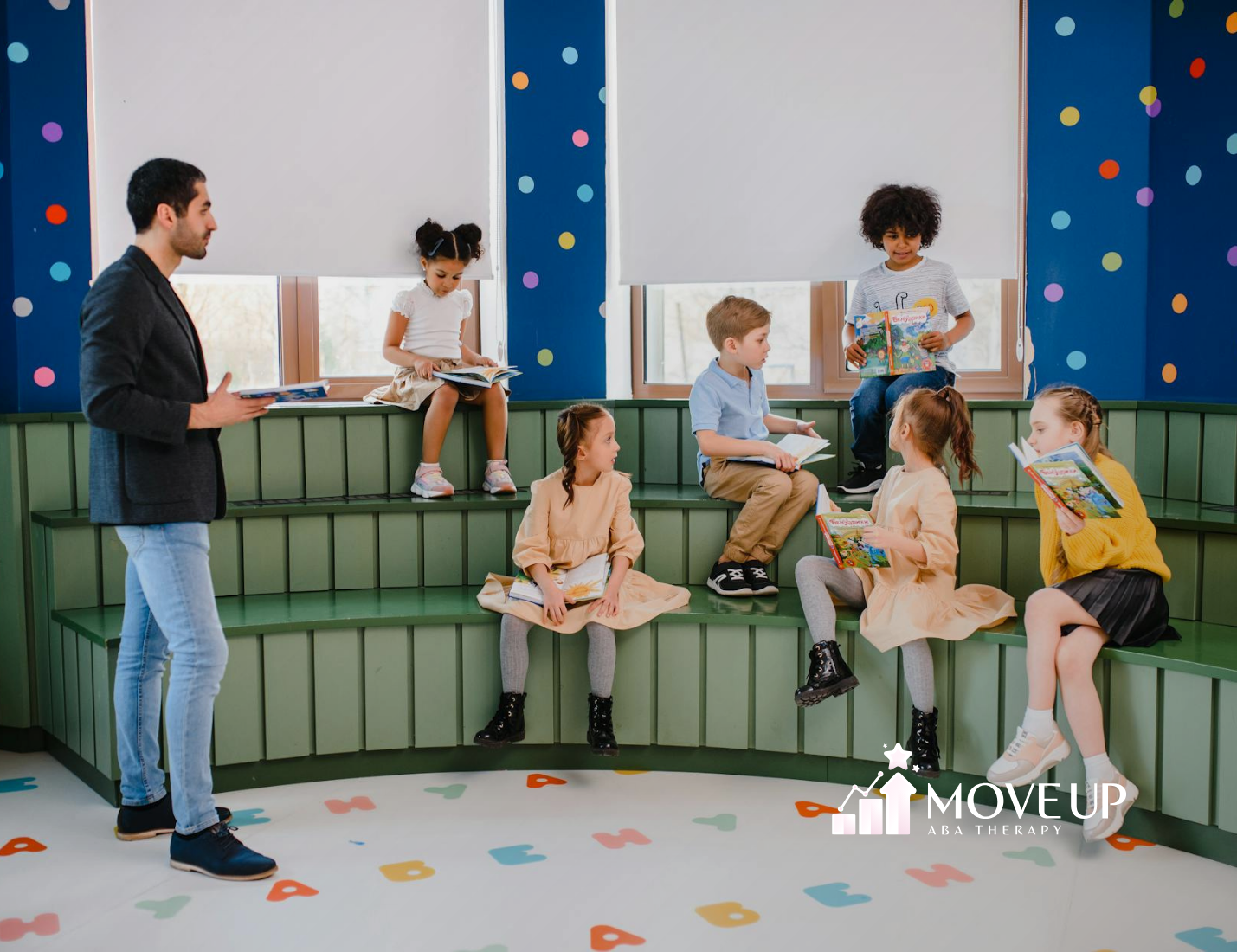Implementing ABA techniques at home can significantly reinforce professional sessions and help children translate skills into their daily routines. While a study from the National Institute of Health found that center-based ABA therapy achieved 100 percent more learning per hour compared to home-based settings, combining both approaches leads to well rounded gains. Parents and caregivers play a vital role by embedding behavior principles into everyday moments, creating a consistent, supportive environment that fosters communication, social skills and positive behaviors.
This guide shows simple steps for implementing ABA techniques at home. It covers essential methods such as positive reinforcement, discrete trial training and pivotal response training. It also outlines practical tips on preparing the home setting, improving collaboration with professionals and tracking progress to ensure meaningful outcomes.
Home Based ABA Overview
Applied Behavior Analysis (ABA) therapy is a scientifically validated approach that uses behavior science to teach new skills and reduce challenging behaviors. Traditionally delivered in clinics or centers by registered behavior technicians under Board-Certified Behavior Analysts, ABA can also be adapted for home settings. In-home practice lets families observe techniques firsthand and generalize skills across natural routines.
Parental involvement is a cornerstone of successful home-based ABA. Research shows that caregivers who actively participate in sessions and implement strategies at home see greater progress and better skill generalization in their children. By working alongside therapists, parents learn how to prompt responses, deliver reinforcers and shape behaviors in real time.
Benefits Of Home Practice
- Reinforcement in natural settings boosts maintenance of learned skills
- Hands-on parent training increases caregiver confidence
- Consistent application across environments reduces behavior spikes
- Family members witness progress and adjust strategies promptly
Key ABA Techniques
Selecting the right mix of ABA strategies can address both skill deficits and behavior challenges. Below are core techniques that families can implement under professional guidance.
Positive Reinforcement
Positive reinforcement involves delivering a reward immediately after a desired behavior to increase its occurrence. At home, natural reinforcers, such as praise, a favorite toy or video game time, make rewards more meaningful.
- Identify what motivates the child by observing interests
- Pair specific behaviors (for example, completing a chore) with chosen reinforcers
- Fade extrinsic rewards over time to encourage intrinsic motivation
Discrete Trial Training
Discrete Trial Training (DTT) breaks skills into small, structured lessons. Each trial includes a clear instruction, the child’s response and a consequence (reinforcement or correction). DTT is ideal for teaching academic and language targets.
Key Steps in DTT:
- Present the instruction (“Touch the red block”)
- Wait up to 5 seconds for a response
- If correct, deliver reinforcement immediately
- If incorrect, provide a prompt and retry
Pivotal Response Training
Pivotal Response Training (PRT) takes a more naturalistic approach. It targets pivotal areas, like motivation and self-management, by embedding learning opportunities in play and daily routines.
PRT Features:
- Child-led activities to harness interests
- Natural reinforcers tied to the behavior (for instance, handing over a ball after requesting “ball”)
- Focus on generalization by varying materials and settings
Task Analysis And Prompting
Task analysis divides complex activities into a sequence of manageable steps. Caregivers can teach tasks such as hand washing or tooth brushing by guiding the child through each component, then fading prompts as independence increases.
Prompting Hierarchy:
- Full physical prompt (hand-over-hand guidance)
- Partial physical or gestural prompt
- Verbal prompt
- Independent response
Operant Extinction
Operant extinction stops reinforcement for previously rewarded, undesired behaviors to decrease their frequency. For example, if a tantrum has reliably led to attention, parents withhold attention until the behavior stops, then reinforce calm behavior.
Use extinction carefully:
- Combine with teaching an alternative behavior
- Ensure safety and consistency
- Prepare all family members to respond alike
Preparing The Home Environment
A structured, predictable setting helps children focus and learn new skills more effectively. Caregivers can make simple modifications to support therapy goals.
Creating A Structured Routine
Consistency is critical. Daily schedules that include designated learning times, breaks and preferred activities help children anticipate transitions and reduce anxiety.
- Use a visual schedule with pictures or icons
- Link activities to specific times of day
- Review the schedule each morning
Managing Environmental Distractions
Minimizing background stimuli lets the child concentrate on tasks. A quiet corner or a small table setup can serve as the primary learning space.
- Select a low-traffic room or area
- Turn off electronics and remove unrelated toys
- Keep materials organized in labeled bins
Using Visual Supports
Visual cues enhance comprehension and independence. Timers, checklists and choice boards guide children through tasks and routines.
- Place a timer to signal work periods and breaks
- Use a picture choice board for requesting items
- Display a step-by-step chart for multi-step tasks
Enhancing Parent-Therapist Collaboration
Open communication between caregivers and professionals ensures consistency and fine-tuning of strategies.
Establishing Clear Communication
Regular check-ins create a feedback loop. Parents may share observations from home, while therapists adjust intervention plans based on real-world data.
- Schedule weekly brief calls or video sessions
- Use shared logs or apps to record behaviors and reinforcers
- Discuss successes, challenges and next targets
Participating In Functional Behavior Assessments
Functional Behavior Assessments (FBAs) identify triggers and functions of challenging behaviors. Caregivers’ input on antecedents and consequences in home routines is invaluable for crafting Behavior Intervention Plans.
Key FBA Components:
- Direct observation in various settings
- Caregiver interviews about behavior patterns
- Data collection on antecedents, behaviors and consequences (ABC)
Overcoming Common Challenges
Home-based ABA may present hurdles such as resource limits, consistency issues and managing intense behaviors. Targeted strategies can address each barrier.
Consistency Across Settings
When extended family or babysitters are involved, inconsistent responses can undermine progress. Training all caregivers to follow the same protocols preserves gains.
- Create a simple protocol document with prompts and reinforcers
- Hold a brief orientation for new caregivers
- Post key strategies near the learning area
Resource And Time Constraints
Not every household has access to specialized materials. Everyday items can substitute for therapy tools, and short daily sessions often yield benefits over long, infrequent blocks.
- Use kitchen utensils or colored cups for teaching sorting
- Turn cooking or laundry into learning opportunities
- Plan 10–15 minute focused sessions 3–5 times per day
Addressing Challenging Behaviors
Problem behaviors like aggression or self-injury require careful management. A well-designed Behavior Intervention Plan (BIP) includes prevention strategies, teaching replacement skills and consistent reinforcement.
BIP Checklist:
- Identify triggers and functions via FBA
- Teach alternative behaviors (for example, “use words to ask for help”)
- Apply reinforcement and extinction procedures consistently
Tracking Progress And Outcomes
Data collection is the backbone of ABA. Continuous monitoring helps caregivers and therapists gauge effectiveness and make data-driven adjustments.
Data Collection And Analysis
Simple tracking sheets or digital apps record the frequency, duration or intensity of target behaviors and skill demonstrations.
- Count occurrences of a behavior per session
- Note duration for tasks like independent play
- Graph data weekly to visualize trends
Adjusting Strategies
Periodic review of data guides decisions on fading prompts, changing reinforcers or introducing new targets. Collaborative meetings between caregivers and therapists ensure alignment on next steps.
- If skill mastery reaches 80 percent across sessions, reduce prompts
- Swap reinforcers if motivation declines
- Introduce advanced targets once foundational skills stabilize
Conclusion
Home-based ABA empowers families to reinforce learning in natural contexts. By combining proven techniques—positive reinforcement, discrete trial training, pivotal response training and more—with structured routines, clear communication and consistent data tracking, caregivers can foster meaningful progress. Parents and therapists working as a team ensure that skills generalize across settings and lead to lasting gains. Families might begin by setting up a simple visual schedule or trialing positive reinforcement for a daily task. With each small success, confidence grows and children thrive in a learning environment that feels both supportive and familiar.
At Move Up ABA, we understand the transformative power of home-based therapy. Our expert team works closely with families to create personalized ABA therapy programs in Maryland and Virginia that integrate seamlessly into daily routines. By combining proven techniques and consistent support, we help your child thrive in their most comfortable environment, empowering you as a parent to become an active partner in their development.
Contact us today to schedule your consultation and learn how our home-based therapy programs can help your child make lasting progress. Let’s work together to create a supportive environment for growth, confidence, and success!
Frequently Asked Questions
What are the advantages of home-based ABA therapy for children with autism?
Home-based ABA therapy offers the advantage of teaching skills in a natural environment where children feel comfortable. It allows for real-world practice, making it easier for them to generalize the skills they learn to daily life.
How does home-based ABA therapy work?
Home-based therapy includes techniques like positive reinforcement, discrete trial training, and pivotal response training. These strategies are tailored to your child’s unique needs and are implemented by both therapists and family members to ensure consistent progress across different settings.
How do I get started with home-based ABA therapy?
To get started, simply schedule an assessment with one of our certified behavior analysts. From there, we will design a customized therapy plan, provide you with training on how to reinforce the skills at home, and begin working together to achieve your child’s goals.
SOURCES:
https://my.clevelandclinic.org/health/treatments/25197-applied-behavior-analysis
https://www.autismparentingmagazine.com/aba-therapy-activities-guide/
https://www.autismparentingmagazine.com/parents-aba-therapy-home/
https://online.regiscollege.edu/blog/aba-therapy-examples/
https://gsep.pepperdine.edu/blog/posts/aba-techniques-strategies-for-behavior-analysts.htm
https://asatonline.org/for-parents/learn-more-about-specific-treatments/applied-behavior-analysis-aba/aba-techniques/






